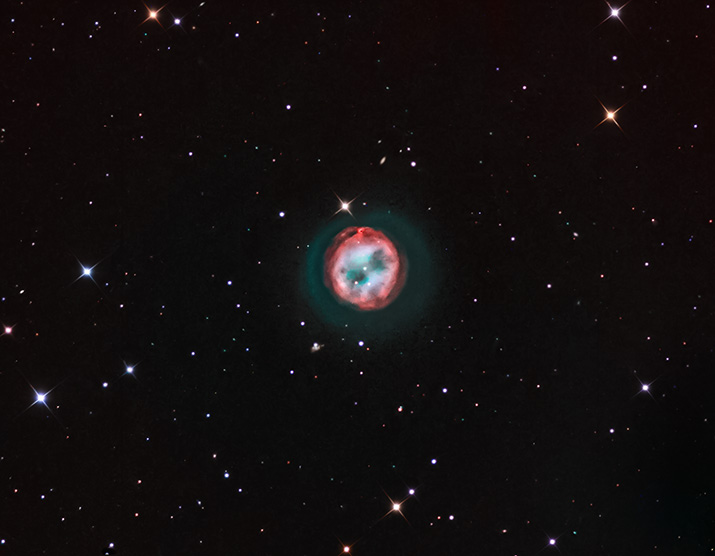
| Date: April 12-14-15, 2023 - Location: Davis Mountains west of Fort Davis, TX Click on the image to view at higher resolution. |

| M97 - The Owl Nebula M97 (NGC 3587, The Owl Nebula) is a planetary nebula located in the constellation Ursa Major approximately 2,600 light years distant[1]. The nebula has a roughly round shape with 2 dark spots on either sides of the central white dwarf star[1]. These features suggest the "eyes" in the round face of an owl, thus its common name. Planetary nebulae have nothing to do with actual planets. The name is due to the generally round shape, similar to planets, early astronomers observed in thier telescopes. A planetary nebula is the last stage in the life cycle of a medium sized star. As the star ages, it depletes its available supply of fusionable fuel and progresses through stages that throw off its outer layers of atmosphere until only a dead, very hot, core remains. This hot core, now a white dwarf star, radiates heavily in the ultraviolet spectrum causing the expelled stellar gasses to glow. Over time, thousands of years, the nebular gases will dissipate and disappear into interstellar space[1]. The Owl Nebula is a complex celestial object. The bubble of ejected gas that comprises the nebula is constrained by the interstellar medium. The expansion rate is slowed down and a shock front forms around the periferia of the bright core resulting in the red outer ring.[1]. Many planetary nebula have an extended faint surrounding halo[2,3]. The outer halo surrounding M97 was detected and documented in 1991 by K. B. Kwitter et al[4,5]. These halos are very faint and can be as much as 10,000 times dimmer than the bright central area of the nebula[1]. Displaying the dim halo around The Owl was a major goal in collecting the data for this image. I used 5 hours of narrowband OIII filtered exposures in order to bring out this remarkable feature surrounding M97. The halo displayed in my image appears asymmetrical in shape with the northern and eastern (up and to the left) portions more compressed than the less dense appearing southern and western sections. I did not find any scientific documentation related to the cause of this asymmetrical feature. I speculate that two explanations could possibly account for the asymmetrical shape. First, and probably the most likely, is the planetary, as a whole, is moving through the interstellar medium in a north easterly direction. The second explanation is that the interstellar medium is denser to the north and east of M97 and compresses the gasses to a greater extent as they expand in that direction. Examination of the OIII filtered data reveals a narrow gap, or dimming, in the faint halo located in the image at the 12:00 o'clock position. This feature is aligned with a Ha (hydrogen alpha) prominence in the red rim of the planetary. Dr. Don Goldman noted this feature[2] and referenced a similar gap in M27. It is possible the Ha prominence and the OIII gap are related .My stretched OIII filtered image showing the gap may be viewed here. Member of the Dark Sky Observatory Collaborative References1Anne's Astronomy News: http://annesastronomynews.com/photo-gallery-ii/nebulae-clouds/the-owl-nebula-by-don-golman/ 2Astrodon: https://astrodonimaging.com/gallery/the-owl-gets-a-halo/ 3Balick et al: https://articles.adsabs.harvard.edu//full/1992ApJ...392..582B/0000582.000.html 4K. B. Kwitter et al: https://articles.adsabs.harvard.edu/pdf/1993IAUS..155..209K 5Seds: http://www.messier.seds.org/m/m097.html
|